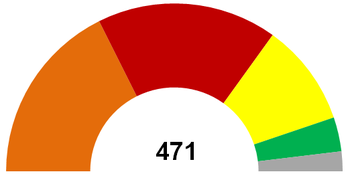Romanian legislative election, 2008
|
|
||||||||||||||||||||||||||||||||||||||||||||||||||||||||||||||||||||||||||||||||||||||||||||||||
|
||||||||||||||||||||||||||||||||||||||||||||||||||||||||||||||||||||||||||||||||||||||||||||||||
|
||||||||||||||||||||||||||||||||||||||||||||||||||||||||||||||||||||||||||||||||||||||||||||||||
|
|
||||||||||||||||||||||||||||||||||||||||||||||||||||||||||||||||||||||||||||||||||||||||||||||||
|
||||||||||||||||||||||||||||||||||||||||||||||||||||||||||||||||||||||||||||||||||||||||||||||||
Legislative elections were held in Romania on 30 November 2008. The Democratic Liberal Party (PD-L) won most seats in both the Chamber of Deputies and the Senate, although the alliance headed by the Social Democratic Party (PSD) won a fractionally higher vote share.
President Traian Băsescu had wanted to introduce a single-winner two-round electoral system before this election, but a 2007 referendum on the proposal failed on insufficient turnout. A new electoral system was introduced as a compromise. Thus, this was the first suffrage in which the electoral system was changed from party-list proportional representation to a mixed member proportional representation system, and the first one to feature sub-county constituencies, called electoral colleges (colegii electorale). A candidate wins in any electoral college in which they obtain more than 50% of the vote. Seats where no candidate wins an outright majority are then allocated using the D'Hondt method. If necessary, the number of seats for each chamber is raised, by giving supplementary seats. An electoral threshold was applied of 5% for each chamber; or winning at least six colleges for the Chamber of Deputies and three colleges for the Senate by more than 50%. There was an additional adjustment for the Chamber of Deputies around the national minorities candidates.
...
Wikipedia




